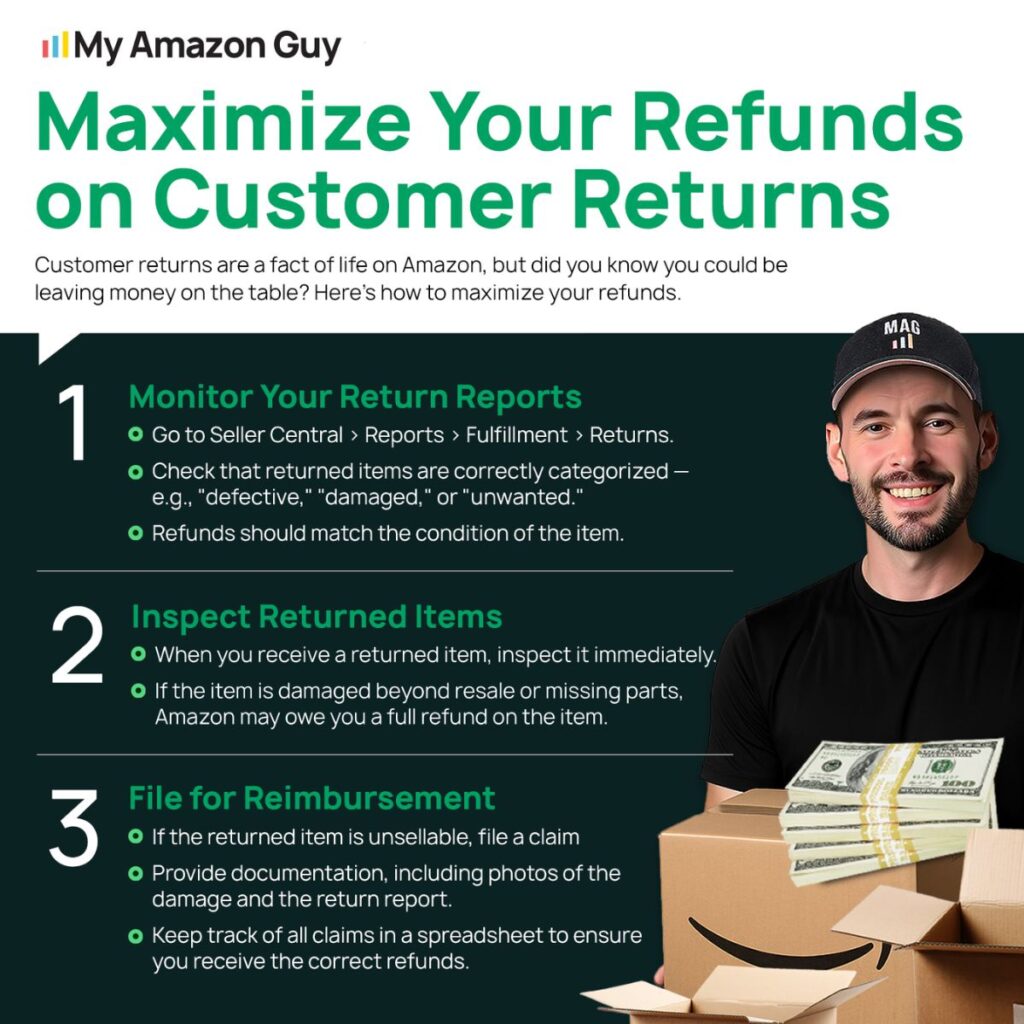
To give shoppers more flexibility and peace of mind, Amazon extends its return window during the holiday season through its Amazon Extended Holiday Return Policy. But what does this really mean for sellers trying to keep their profits and inventory in check?
Amazon has always positioned itself as a customer-centric platform, consistently creating policies that favor buyer satisfaction, from fast shipping to no-hassle returns. This approach has built strong customer loyalty; in fact, 53% of online shoppers prefer Amazon largely because of its generous return policy that lets them buy with confidence.
What’s more, during the holidays, Amazon goes the extra mile by extending the standard return window to accommodate gift buyers. While this helps boost customer confidence and sales, it can also complicate things for sellers, especially when managing inventory, refunds, and post-holiday returns.
In this guide, our Amazon agency will explain how Amazon’s extended holiday return policy works and what it means for sellers. We’ll also share practical tips to help you manage returns efficiently and protect your profit margins during the busy season.
Table of Contents
Stay Ahead of Holiday Returns
Avoid last-minute surprises by preparing your Amazon store for the extended return window.
What Is the Amazon Extended Holiday Return Policy?
Amazon’s standard return policy usually allows customers to send back most items within 30 days of receipt. However, during the busy shopping months, Amazon introduces the Extended Holiday Return Policy to give customers more time to return items bought as gifts or during year-end sales.
For 2025, most items purchased between November 1 and December 31 can be returned until January 31, 2026. This extended window helps customers shop early without worrying about missing the return deadline, though there are exceptions.
Why Sellers Need to Know About the Extended Holiday Return Policy
Although some sellers may think that the extended return window won’t have a significant impact on their business, that’s far from the case. This seemingly small change could lead to a range of operational challenges, ultimately affecting profit margins and seller performance.
1. Increased Costs
The extended return window puts additional financial strain on sellers due to return processing, shipping, restocking, and disposal of unsellable items. For FBA sellers, Amazon’s introduction of returns processing fees for products with high return rates makes this an even bigger burden.
2. Loss of Profit
When a returned item is refunded, the seller loses not only the revenue from that sale but also the profit margin they originally made. This loss compounds when high return rates occur, further eroding the seller’s bottom line during peak sales periods.
3. Product Depreciation
Returned items, especially those that are opened or damaged, may no longer be in a sellable condition and often need to be sold as “used” at a discount or liquidated. This results in significant financial loss for sellers who can’t resell the items at full price.
4. Cash Flow Issues
With the extended return window, final sales are not confirmed until months later, making it difficult to forecast cash flow accurately. Q4 sales, for example, can be affected until late January or February, which disrupts planning and financial stability.
5. High Volume of Returns
Sellers face a massive surge in return requests come January, requiring significant time and resources to process, especially for FBM sellers who handle returns independently. This overwhelming volume can disrupt day-to-day operations and strain resources.
6. Increased Risk of Return Fraud
The lengthy return window opens the door for return fraud, such as customers “wardrobing” (using an item and returning it) or swapping items. This risk not only causes direct losses but can also damage the seller’s reputation and lead to further complications.
Simplify Your Return Management
Let our experts handle the chaos of holiday returns so you can focus on growing your brand.
Best Practices for Handling the Amazon Extended Holiday Returns
This is why sellers need to prepare a solid strategy for handling returns to minimize the negative impact of the extended return window. By taking proactive steps, sellers can reduce the strain on their operations and protect their profits during the busiest season of the year.
1. Manage Your Cash Flow Proactively
Cash flow will be one of the biggest challenges during the extended return window. Amazon often holds a higher reserve from seller payments to cover potential refunds, which limits available cash.
To stay prepared, plan your finances with this delay in mind and keep extra capital on hand for restocking in Q1. This ensures your business stays liquid even when payouts slow down due to post-holiday returns.
2. Forecast and Monitor Return Rates
Understanding your typical return rate is key to forecasting how much the extended policy might affect your business. Most categories average between 1% to 5% returns, but giftable products can spike by 25%–50% in January.
Check your FBA or FBM returns reports early to anticipate the surge. Tracking this data helps you plan inventory restocks and prevent unexpected losses.
3. Strengthen Packaging and Product Quality
Damaged goods are one of the leading causes of returns, especially during the shipping rush. Use sturdy materials and double-check that fragile items are properly cushioned.
Also, audit your suppliers’ quality control before Q4 to ensure products meet standards. Well-packaged and durable items drastically reduce the odds of being returned.
4. Review Returned Item Evaluation Settings
This setting determines whether Amazon inspects returned items for resale eligibility. Keeping it enabled ensures that items in good condition can be returned to your inventory and resold.
If you disable it, Amazon automatically marks those products as unfulfillable, which prevents reimbursement for damaged goods. Most sellers benefit from keeping this setting on to recover maximum value from returns.
5. Reassess Damaged Inventory Ownership Settings
When Amazon damages a product, they typically reimburse you for the sourcing cost and take ownership of it. This means they can resell your damaged inventory under “Amazon Warehouse”, sometimes competing with your own listings.
Consider disabling this option if you want full control over your damaged products, even if that means covering removal costs. The trade-off is better protection of your brand and pricing integrity.
6. Optimize Returnless Resolutions Settings
Amazon lets sellers decide whether customers can receive refunds without sending items back. For certain low-cost or non-resellable products, this option might actually save you money.
Use it selectively; turn it on for products that are often damaged or not worth shipping back, and keep it off for items that can be resold. This helps balance cost efficiency with customer satisfaction.
7. Improve Listing Accuracy and Clarity
Most returns happen because customers receive something that doesn’t match their expectations. Review your product titles, bullet points, and descriptions to make sure they clearly communicate size, color, and features.
Include accurate measurements, product compatibility, and lifestyle photos to minimize confusion. The clearer your listings, the fewer returns you’ll face from customer misunderstanding.
8. Respond Quickly to Return Requests
Timely responses to return requests keep customers happy and protect your account metrics. Try to respond within 24 hours of receiving a request, whether approving, declining, or clarifying.
Quick communication shows professionalism and can prevent escalation to A-to-Z Guarantee claims. It also reduces negative feedback that could hurt your performance score.
9. Track and Document Every Return
Maintain detailed records of all return activities, like shipment IDs, item condition, refund amount, and communication with the buyer. This documentation is vital for resolving disputes or fraudulent claims.
You can use Amazon’s return reports to identify return trends by ASIN or category. Over time, this data helps you refine your listings and reduce future return rates.
10. Learn From Returns to Improve Future Sales
Every return is an opportunity to learn what didn’t work for the customer. Review feedback to identify whether it’s a product issue, unclear listing, or unrealistic expectation.
Use this insight to improve your product images, descriptions, or packaging. Showing customers you act on feedback not only reduces returns but also strengthens your brand’s credibility.
Amazon Extended Holiday Return Policy FAQs
Does the Amazon Extended Holiday Return Policy apply to all sellers?
Yes. The extended holiday return window applies to both FBA and FBM sellers as long as the item is fulfilled through Amazon or follows Amazon’s return guidelines. However, FBM sellers must ensure their return policies align with Amazon’s minimum requirements during this period.
How can sellers minimize the impact of post-holiday returns?
Sellers can reduce return rates by improving product accuracy, packaging quality, and customer communication. Reviewing return data after the holidays helps identify problem areas, like misleading descriptions or defective batches, to fix before the next sales cycle.
Will Amazon hold more of my funds during the extended return period?
Yes. Amazon often increases payment reserves during the extended return window to cover potential refunds. This can temporarily limit your cash flow through January, so it’s smart to plan ahead for inventory and operating expenses.
The Real Cost of the Amazon Extended Holiday Return Policy
The Amazon return policy has always favored customers because the platform prioritizes their satisfaction above all else. This becomes even more evident during the holidays when Amazon extends the return window to give buyers more flexibility in returning gifts.
Although some sellers might not see this as a major change, it can significantly affect cash flow, inventory planning, and profitability. That’s why it’s crucial for sellers to prepare strategies that help manage returns efficiently and minimize potential losses.
Are you having trouble managing your holiday returns? Let our full-service Amazon agency help you streamline refunds and protect your profits while keeping your operations running smoothly.
Protect Your Profit Margins This Season
Extended returns can eat into your profits—learn how to keep your margins safe.





